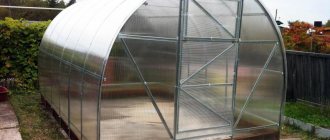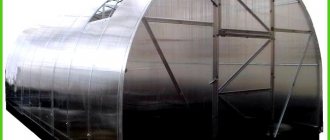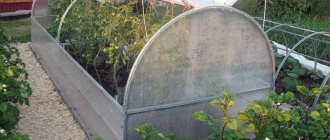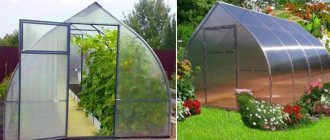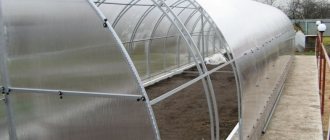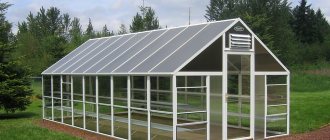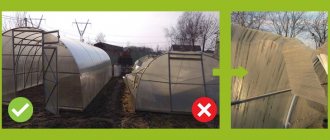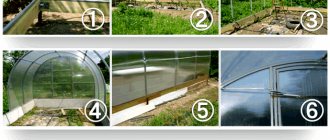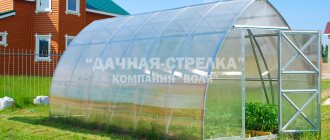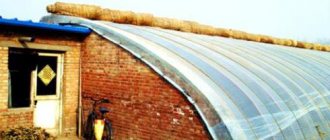A product such as the Siberian greenhouse has been on the market for quite some time and is becoming increasingly popular today.
This is not particularly surprising, if only because in Siberia, with its harsh climate and short summers, it is simply impossible to do without high-quality, convenient and reliable greenhouses. However, reviews of Siberian greenhouses indicate that they are used in various parts of our country. At the same time, the name of the greenhouse “Sibirskaya” has already become a real brand, recognizable and in demand. Today, in summer cottages and household plots, it is increasingly rare to see homemade greenhouse buildings made from old frames covered with polyethylene. Self-respecting owners, as a rule, give preference to ready-made options with a prefabricated frame and polycarbonate coating. Not too different from other options in price, such greenhouses have a number of undoubted advantages.
Greenhouse "Sibirskaya"
In the harsh conditions of the Siberian climate, growing crops in open ground becomes significantly more difficult, and in some situations becomes completely impossible. Therefore, those who want to eat not imported, but their own vegetables and berries, have to adapt and look for ways to protect plants from cold, wind and night frosts. One of the most effective solutions to all these problems was the Sibirskaya greenhouse from. By the way, a number of other companies are also engaged in the production of such greenhouses, but the dimensions and characteristics are the same for all.
Features of the climate of Siberia
The period favorable for growing vegetables and other crops in open ground is very short in Siberia and ranges from 80 to 100 days, and this is in relatively warm areas of this region. The main reason for this severity is the cold - winters here are long, snow can remain until the end of May - beginning of June. At the same time, the summer itself is short, and frosts may begin as early as August, threatening to destroy everything that grows on the plot. In addition, the soil in Siberia freezes greatly during the winter, up to 2-3 meters.
The harsh continental climate with significant temperature changes does not make it more attractive for growing vegetables and berries. And the last important factors that make Siberia a harsh region are strong winds and a general lack of sunlight. Due to the latter factor, the cultivation of some agricultural crops becomes completely impossible.
The Sibirskaya greenhouse appeared in such conditions as an effective and relatively inexpensive solution to the problems faced by summer residents. How does it work and how to build it yourself? You can find answers to these questions in this article.
Greenhouse design for Siberia made of polycarbonate
The most common design is arched. This form was also chosen for the “Siberian” greenhouse. The arcuate surface scatters the sun's rays better than others. This provides the plants with optimal light conditions. In winter, the arch is convenient because snow does not accumulate on its surface. In the manufacture of the frame, a galvanized steel pipe with a cross-section of 25×25 mm, 40×20 mm is used.
Steel is not subject to corrosion and has a high tensile strength. The zinc coating gives it a presentable appearance. The frame connections are made with T-shaped elements and secured with bolts. You can also use welding, but then the structure will be one-piece, and you will not be able to transport it to another place. Consists of 6 or more sections, depending on size. The greenhouse is available in several sizes: 12, 18, 24 and 30 m².
Dimensions of these models: 4.2 × 3 × 2.1 m; 6.3×3×2.1 m; 8.4×3×2.1 m; 10.5×3×2.1 m. The covering is made of polycarbonate panels. The material transmits light perfectly, is durable, but at the same time easily restores its shape after exposure to external factors. Polycarbonate is a new material, sheets of which can withstand temperatures from –30°C to +100°C. In addition, it is 50 times stronger than glass and 12 times lighter.
Technical specifications:
- permissible mechanical load: 40 kg/m²;
- resistance to wind gusts up to 22 m/s;
- transmits light well;
- has low thermal conductivity;
- easy to install and dismantle.
Polycarbonate greenhouses have many advantages. They are provided by the qualities of the material - polycarbonate. It is impact-resistant, load-resistant, non-flammable, bends easily, but resists mechanical damage. No shortcomings have been noticed yet.
Design
“Sibirskaya” is an arched polycarbonate greenhouse assembled on a metal frame. It, in turn, is made of galvanized steel pipe with a cross-section of 25x25 mm, which ensures the durability of the building, as well as resistance to corrosion and snow loads. It is possible to change the design of the greenhouse and replace the profile with wooden beams or plastic, but it is not advisable. The frame elements are assembled together using T-shaped and cross-shaped connectors; bolts and nuts with washers are used as fasteners. If necessary, you can use welding, but in this case the frame will turn out to be one-piece.
On a note! As an alternative, it is allowed to use a metal profile or galvanized pipes with a cross-section of 20x20 mm or more. If the material does not have an anti-corrosion coating, painting is required.
For such a greenhouse, it is necessary to create a foundation and secure the base of the frame on it. This reduces the risk of damage to the building by strong gusts of wind. In addition, the foundation will separate the soil in the greenhouse from the rest of the earth - warming it up in the spring will become much easier.
The cladding is not thin film or fragile glass, but cellular polycarbonate - the most durable of transparent polymers. The material has in its structure a number of cells filled with air, which serve as good thermal insulation, protecting plants from early frosts. For greater efficiency, all joints and fastening points of sheathing elements are sealed whenever possible - cracks are undesirable in a greenhouse. Additionally, the building can be equipped with an automatic ventilation, watering and heating system, as well as a “dressing room” designed to not release heat when entering or leaving the greenhouse.
Table. The main parameters of the Siberian greenhouse options.
| Length, m | 4,2 | 6,3 | 8,4 | 10,5 |
| Width, m | 3 | 3 | 3 | 3 |
| Height at the highest point of the arch, m | 2,1 | 2,1 | 2,1 | 2,1 |
| Internal area, m2 | 12 | 18 | 24 | 30 |
| Greenhouse frame weight, kg | 70 | 90 | 110 | 130 |
Tips for care, operation of the greenhouse
If, after harvesting, you leave the cleaning in the greenhouse until spring, during this time a lot of pests and microbes will multiply. In the fall, be sure to remove tops and other plant debris, remove or preserve the irrigation system for the winter, and remove auxiliary equipment. The panels can be washed with ordinary laundry soap both outside and inside. Frame joints can be cleaned with a soft brush.
It is convenient to quickly and reliably disinfect the entire space using a sulfur bomb. The peculiarity of sulfur smoke is that it easily penetrates into the ground and hard-to-reach places. This kills both microbes and pests. But you must use the sulfur bomb in accordance with the instructions, since the substance is toxic to humans. The greenhouse must be tightly closed, and you can enter there no earlier than 3 days after the end of processing.
Some gardeners advise creating a reinforced structure by installing additional elements. These can be duplicate arches or crossbars. Arched roofs are designed to not accumulate snow. But in winter, after heavy snowfalls, it is advisable to check the integrity of the structure and, if possible, remove snow if there is any on the roof or near the walls. You need to remove snow from the walls to make room for snow that will fall from the roof.
Did you know? The first modern greenhouses were created by Italians. The need arose during the era of great geographical discoveries. Exotic plants from southern countries were beautiful, but needed to create conditions suitable for them.
In the spring, the greenhouse needs to be ventilated, damaged elements repaired, cracks treated with sealant, and opening mechanisms lubricated or repaired. Before starting field work, it is advisable to disinfect the soil from phytopathogens with a 3% solution of copper sulfate. There are no difficulties with installing the “Siberian” greenhouse. With proper care, it will last for many years, providing plants with acceptable conditions for growth and development in unfavorable climates.
Marking the site and creating a foundation
Work on creating a “Siberian” greenhouse begins with choosing the site on which it will be located. First, assess the light level - plants in the greenhouse should be exposed to the sun during the day for as long as possible, shading from nearby buildings or trees is undesirable. Secondly, study the landscape - is there a slope and in which direction, how difficult will it be to level the area. Thirdly, the “Siberian” greenhouse must be correctly oriented to the cardinal points - the narrow ends face west and east, and the long walls face north and south, respectively.
Common models and their differences
It is better to purchase high-quality and reliable Siberian greenhouses from trusted manufacturers. The most popular models on the market are those from two major manufacturers.
The first is Krasnoyarsk, which produces the following models:
- greenhouses with an arched steel frame and a polycarbonate covering;
- greenhouses with an arched frame;
- “Botanik” series – products made of aluminum profiles with a gable roof; the coating material can be glass or polycarbonate.
The second popular one is from Barnaul. They have a whole series of polycarbonate greenhouses called “Siberian”:
- "Sibirskaya-1M" has a length of 4 m, increased by 2-meter modular inserts;
- “Sibirskaya-2” has a length of 4 m, is designed for extreme weather conditions, and is expanded in the same way due to modules;
- "Sibirskaya-3" has a length of 5 m, there are no modular inserts.
On request, frames longer than 8 m can also be manufactured, which are equipped with additional ventilation vents.
The third leader is the Novosibirsk plant, which produces a popular line of models:
- greenhouse “Siberian - reliable” standard;
- Greenhouse "Sibirskaya - reliable" mobile.
The mobile version is easily assembled using pipe-to-pipe fastening, simply transported and, if necessary, dismantled. Due to its compactness, inexpensive delivery to the regions is obtained.
Sheathing of the “Siberian” greenhouse
The process of cladding the greenhouse frame begins with installing a sheet of cellular polycarbonate (or CPK for short) on the gables. Roofing screws with thermal washers are used as fasteners. The thickness of the SPK sheets used is 4 mm.
Step 1. Using a utility knife, cut a standard sheet of cellular polycarbonate into two parts, each 3 m long and 2.1 m wide.
Step 2: Remove the protective film from both sides of the sheet.
Step 3: Take one of the pieces and lean it against the gable of the greenhouse, with the stabilizing side facing out. The SPK sheet must completely cover the pediment.
Step 4. Fix the sheet on the pediment using clamps or the efforts of an assistant.
Step 5. Tighten the screws at the corners of the gable and at the top.
Step 6. While continuing to hold the sheet, tighten the screws along the entire length of the arch and on the base. Be careful when doing this, do not allow the formation of dents and deflections in the fastening areas.
Step 7. Screw the screws onto the door frame, door, window and other gable elements.
Step 8. Using a utility knife, cut off the excess polycarbonate so that the sheet matches the dimensions of the pediment and takes on a semicircular shape.
Step 9. Cut out the door and window from the sheet. Their frames should act as a “cutting line”.
Step 10. Cut holes for door hinges. Install handles and latches.
Step 11: Repeat the previous steps with the other part of the sheet and the opposite gable of the greenhouse.
After covering the gables, you need to start working on the rest of the greenhouse frame.
Step 1. Remove the protective film from the SPK sheet.
Step 2. Place it on the frame with the stabilizing layer facing out. The walls of the cells should be parallel to the arches.
Step 3. Align the sheet with the base and arches. Seal the ends of the SPC with perforated tape.
Step 4. Screw the screws into the bottom of the sheet on the left and right walls of the greenhouse.
Step 5. Repeat the previous step with the remaining screws along the entire length of the arch.
Step 6. Install other SPK sheets in a similar way. For greater tightness, they can be installed overlapping or using a detachable connecting profile.
Improved thermal insulation can be achieved by sheathing the greenhouse with cellular polycarbonate in two layers - one on the outside, one on the inside. An air gap 2 cm thick will appear between the sheets of SPC, which can significantly reduce heat loss.
We advise you to familiarize yourself with the following video - it shows the process of assembling the frame of a Siberian greenhouse and covering it with sheets of cellular polycarbonate.
Video - Assembling the Siberian greenhouse
Polycarbonate prices
Step-by-step installation instructions
Installing a Siberian greenhouse made of cellular polycarbonate does not take much time if you strictly follow the instructions. Construction includes several successive stages, each of which should be approached with due attention.
Preparation of the land plot
Such a greenhouse is not built for one year, so even at the preparatory stage, care must be taken to ensure that it stands as reliably as possible. To do this, the land plot allocated for construction must meet the following requirements:
- The terrain should be extremely flat, without significant differences in height. If there are differences of more than 5 cm in height, there is a need to build a terrace and construct a monolithic foundation.
- The site should be as illuminated as possible, without trees and structures providing abundant shade.
- The quality of the underlying soil must be suitable for growing the planned crops. It can be increased by applying special fertilizers in the required proportions.
Foundation Features
Another distinctive property of all Siberian greenhouses is the variety of foundations used for fastening. The frame can be installed on:
- block foundation;
- monolithic base;
- frame made of wooden beams;
- ordinary soil.
If you plan to build a structure for year-round growing of plants, especially for commercial purposes, then you cannot do without a foundation that reaches the freezing level. For seasonal cultivation, you can only use shallow tape and brickwork.
The most budget-friendly option, if the terrain does not allow the structure to be installed directly on the ground, is a frame made of wooden beams with a cross-section of 100×100 mm. A layer of roofing material is placed on the soil, and on top is a wooden box soaked in antiseptics.
Assembly and installation of the frame
Even a person who has never done anything like this can handle the installation of a greenhouse. The kit usually contains detailed instructions, after studying which you can begin assembly:
- First, the lower guide profiles are installed; they are connected using special inserts.
- Using a level, the vertical is verified, and then the fronts and near arcs are attached.
- The front and the arcs closest to it are fastened with longitudinal profiles.
- Then the following arcs are attached at the specified distance and are also connected with profiles.
- Special metal strips are installed to which the polycarbonate sheets will be attached.
The finished structure can be installed on the foundation. If you place the frame directly on the ground, you need to additionally stock up on T-shaped posts. Under them, holes are dug with a diameter of about 20 cm and a depth necessary for uniform installation of the structure (depending on the topography).
Installation of polycarbonate coating (plus assembly video)
The last stage of greenhouse construction will be the installation of polycarbonate sheets. They usually come with a protective film and install directly with it. On the side of this film there is a protective UV layer, marked accordingly. On the inside there are stiffening ribs designed to drain the resulting condensate. When installing, the UV layer must be facing outward, and the stiffeners must be strictly vertical along an arc. This will help prevent premature failure of the coating.
The sheets are fixed with roofing screws with rubberized gaskets and the ability to control the tightening force and, if necessary, adjust it. The joints of the sheets fall exactly on the arcs. They, as well as the upper ends, are recommended to be reliably sealed (with tape or glue-sealant) to prevent excess moisture from entering. The bottom joints are not sealed so that moisture accumulated on the panels can escape.
At the end, the film must be removed from the coating, which, under the rays of the sun, can tightly stick to the sheets.
Reliable Siberian greenhouses made of cellular carbonate are popular among buyers due to their simple installation and time-tested durability. With their help, you can get a harvest of fresh vegetables or berries even in the most severe frosts, if you additionally equip the building with heating and lighting. To dispel any final doubts, consult with professionals who will help you choose the best option for your specific conditions.
